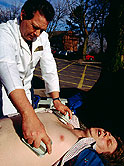Increase in asystole, decrease in pVT/VF, PEA with delay in time from collapse to CPR
FRIDAY, May 1, 2015 (HealthDay News) — For patients with out-of-hospital cardiac arrest (OHCA), outcomes differ by time to first cardiopulmonary resuscitation (CPR) and first documented rhythm, according to a study published online April 30 in Circulation: Cardiovascular Quality and Outcomes.
Masahiko Hara, M.D., from the Osaka University Graduate School of Medicine in Japan, and colleagues enrolled 257,354 adult-witnessed OHCA patients. The authors examined the correlations between time from collapse to first CPR and neurologically favorable one-month survival. There were 38,661 OHCA patients with pulseless ventricular tachycardia/ventricular fibrillation (pVT/VF), 96,906 with pulseless electric activity (PEA), and 121,787 with asystole.
The researchers found that neurologically favorable one-month survival rates were 21.3, 2.7, and 0.6 percent, respectively, for pVT/VF, PEA, and asystole. As the time from collapse to CPR was delayed, there was an increase in the proportion of asystole, and decreases in those of pVT/VF and PEA (P < 0.001). As first CPR was delayed, the estimated incidences of end point after OHCA became lower, regardless of the type of first documented rhythm; however, these differed by the rhythm. For each incremental minute of CPR delay, the average decreases in the probability of neurologically favorable one-month survival were 8.3, 4.4, and 6.4 percent, respectively, for patients with pVT/VF, PEA, and asystole.
“The OHCA outcome differed by time to first CPR and first documented rhythm,” the authors write. “Shortening of time to first CPR is crucial for improving the OHCA outcome.”
Copyright © 2015 HealthDay. All rights reserved.








